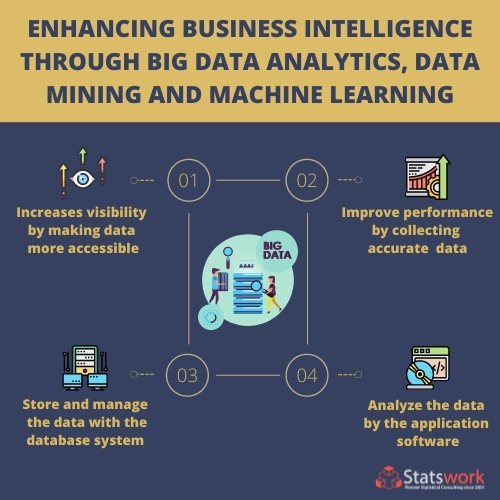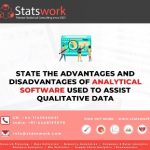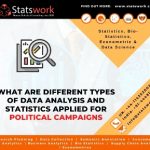Advance analytics Enhancing Business Intelligence through Big Data Analytics, Data Mining and Machine Learning
In Brief
- Big data analysis help organization in improving customer satisfaction, it also helps in handling supply chain creation, decision making, and to increase pricing if adequately utilized.
- Machine learning is revolutionizing this process. With machine learning, valuable information can be found much faster, providing real-time analysis and appropriate insights for the market.
- Business intelligence is more concentrated on documenting and querying; while advanced analytics is based on organization intelligence and concentrates on reporting and querying.
Introduction
The size of business data growing exponentially in recent days, in the business field like manufacturing, is created through sensors, associated devices, cameras, payment systems and other Internet of Things (IoT) applications. Most of the organizations use and operationalize Business intelligence applications. While many businesses already use and operationalize business intelligence applications within their processes to influence data, the true capability of data is still unnoticed in many organizations. Advanced analytics and significantly predictive analytics used to unlock the original value of your data by providing tremendously accurate predictions that include altering variables and hypothetical circumstances.
- Business intelligence helps to describe why something happens in the past; it states the occurrence.
- Advanced analytics is commonly used to describe why something is happening and the effect it might cause if the situation continues for a while.
Business intelligence
It focuses on the structured data to analyze past performances, organize day-to-day operations, and act as guidance for planning the near future. Organizations encourage using business intelligence tools at times when they need to gather and store data regarding the recent operation, to increased workflow and to achieve the current business benchmark.
Some business intelligence tools comprise everything from simple basic spreadsheets to complicated systems for online analytical processing, business activity observing, and Data miningand software. A sound business intelligence system must include complete business metrics, based on the real world (real-time), with information and reports organized to answer specific questions about your operations, which must include the following:
- What happened previously and have it can be described?
- How many time the expected result got deviated?
- How often have abnormalities occurred and how expensive they are?
This information helps in decision making and also used to navigate related organizational challenges.
Working with data from different sources:
Business data is often sailed across various databases, from customer relationship management (CRM) systems to enterprise resource planning (ERP) software to various Excel spreadsheets. Combining the needed information is a time-consuming and challenging task.
Identifying the right indicators:
Business intelligence should provide a general overview of operations—which means you need to observe and record a disparate set of indicators which grabs everything from marketing to stock management to apparatus performance.
Advanced analytics
Business intelligence is more concentrated on documenting and querying; advanced analytics is based on while organization intelligence concentrates on reporting and querying. Advanced data analytics is about improving, correlating, and forecasting the following best action or most likely action.
It helps process the data and then accomplish various functions, comprising correlational analysis, regression analysis, forecasting analysis, text mining, image analytics, pattern matching, cluster analysis, multivariate statistics, and more.
This procedure is used to answer a precise business question which includes the following:
- Why is it occurring?
- What will happen if it continues?
- What will happen in future?
- What are the best things which can happen?
Gathering the answer to these questions will present a massive competitive advantage.

Big Data in improving business value through business intelligence
Big Data Mining Services help an organization in improving customer satisfaction, it also helps in handling supply chain creation, decision making, and to increase pricing if adequately utilized. Based on the examination, it is found that a dealer who uses of big data has the potential ability to increase the working marginal about 60%, which is gained over the market share of the rival. Commonly, there are five major benefits of using big data analytics.
- It helps to increase visibility by making data more accessible.
- It simplifies performance enhancement and inconsistency exposure by gathering precise data.
- It helps in meeting the definite needs of customers by segmenting the population.
- It complements the decision making with automated algorithms by revealing valuable insights.
Data mining for business intelligence in improving business
Business Intelligence is the capability to alter data into information and information into knowledge. Outsource, and insightful data mining services provides the best way to enhance the decision-making process in business. Data Mining Services contains a set of methodologies. Business Intelligence is a set of methods, presentations and technologies to gather, refine and convert the data from transactional and unstructured information (internal and external to the company), in structured data for direct utilization or analysis.
Business Intelligence associates data analysis applications, including ad hoc analysis and querying, online analytical processing (OLAP), mobile business intelligence, real-time business intelligence, operational business intelligence, cloud and software as a service business open-source business intelligence, collaborative BI and location intelligence.
BI technology also contains data visualization, tools for building BI consoles and performance scorecards and key performance indicators. These tools produce findings that are eventually used to advance competitive benefit over rivals, improved and efficient organization processes and risk management.
Machine learning in improving business value through business intelligence
Machine learning technologies are surging ahead in the corporate sector, allowing businesses to make automated decisions with minimal risk, and making businesses more profitable. Let’s look at specific ways that are happening.
Analyzing Sales Data
Digital interaction had a significant impact on the sale function due to the growth in sales-focused data. Sales teams can access metrics from A/B testing, social media platforms, site visits, and more, to make informed decisions. Unfortunately, all this data is challenging to organize and analyze to pinpoint insights in real-time.
Machine learning is revolutionizing this process. With machine learning, valuable information can be found much faster, providing Real-time analysis and appropriate insights for the market. As a result, sales teams can use these insights to focus on leads and prospects, rather than devoting resources to data collection and analysis.
Security
With most customers shopping online, fraud and security have become growing concerns due to abundant criminal activity opportunities. Businesses use multiple online security types to combat this, but the rise in online transactions and the security measures to protect the customer slow down the purchase experience and make it less convenient. The result is chargebacks, lost revenue, and a negative impact on a business’s reputation.
On top of that, the sheer volume of online transactions means that some security measures are more likely to fail.
Machine learning can improve the fraud detection process by automatically searching for fraudulent or suspicious transactions and separating them from legitimate transactions. It can be done by monitoring specific features in a data set and building models that can be used to flag suspicious transactions. Unlike businesses’ efforts to prevent fraud, machine learning can halt the process before the transaction is completed.
Conclusion
Business intelligencemainly focuses on the structured data to analyze past performances, organize day-to-day operations, and act as guidance for planning the near future. Organizations encourage using business intelligence tools at times when they need to gather and store data regarding the recent operation, to increased workflow and to achieve the current business benchmark.
Reference
- Dean, J. (2014). Big data, data mining, and machine learning: value creation for business leaders and practitioners. John Wiley & Sons.
- Chen, H., Chiang, R. H., & Storey, V. C. (2012). Business intelligence and analytics: From big data to big impact. MIS quarterly, 1165-1188.
- Kibria, M. G., Nguyen, K., Villardi, G. P., Zhao, O., Ishizu, K., & Kojima, F. (2018). Big data analytics, machine learning, and artificial intelligence in next-generation wireless networks. IEEE access, 6, 32328-32338.



 Previous Post
Previous Post Next Post
Next Post